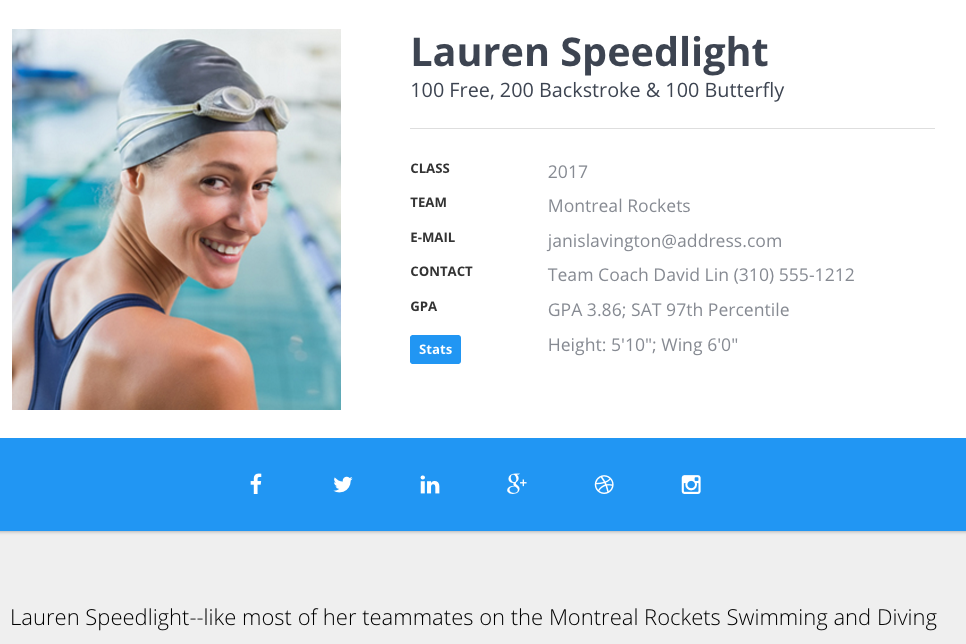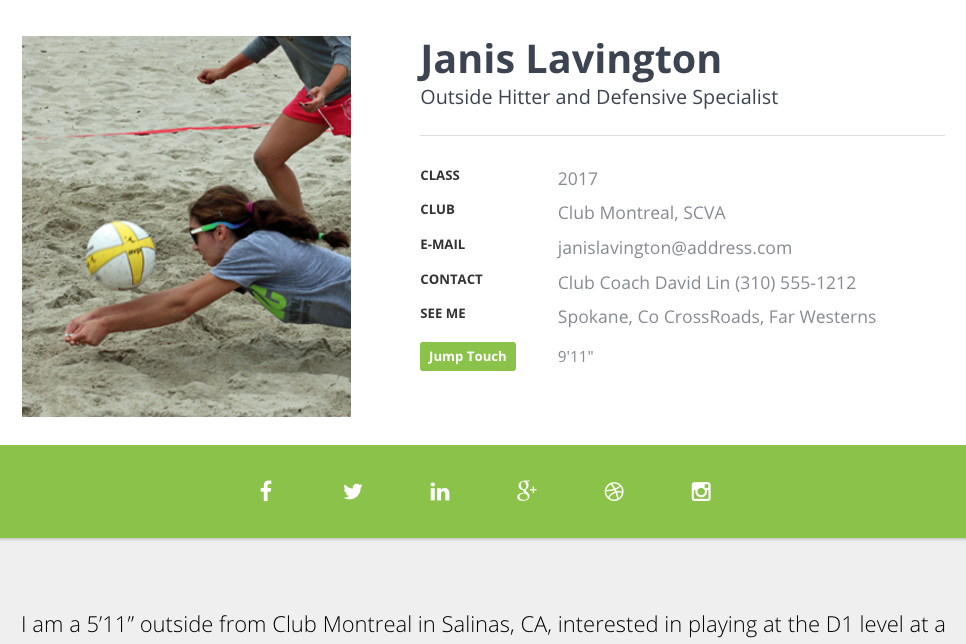If you’re a high school athlete looking to play NCAA golf in college, the first step toward college golf recruiting success is familiarizing yourself with the recruitment rules and processes. Keep reading for an overview of the college golf recruiting process and tips on how to help stand out to NCAA golf coaches. Once you understand how the golf recruiting process works, you’ll be more confident that you are doing everything in your power to get recruited and get that scholarship you've been dreaming of.
The College Golf Recruiting Process - A Step-by-Step Guide
- Initial contact from coach. The unofficial college golf recruiting process begins a player's freshman year, when coaches make their rounds to tournaments and camps. The first communication begins either with an initial contact from the coach in the form of a “nonathletic recruitment publication” such as a "form" email about a camp, flyer, brochure, or questionnaire, or an email sent from a player to a coach. If you receive an email from a coach, you should know that college golf coaches and their recruiting teams might send out hundreds or even thousands of these materials, depending on the size and funding level of the university’s golf program. If you receive one of these emails or letters and it includes a questionnaire, it’s in your best interest to fill out the questionnaire and send it back quickly. But don't think that just because a coach sent you an email that he's strongly interested in you. Early in the process, coaches cast a wide net, and narrow their sights as they move through sophomore and junior year.
- Base evaluations. After a coach makes initial contact, he’ll continue investigating potential athletes. Depending on when this occurs, the coach may or may not be able to contact the athlete directly -- so he will conduct most research by searching online and possibly contacting the athlete’s coaches. The university coach will examine an athlete’s athletic and academic standings by looking at information such as class portfolio, test scores, GPA, game statistics, and performance records. If video footage of the athlete is available, the coach will almost certainly watch it. He/she might begin to rank all potential athletes, creating an ordered list of athletes to pursue in the recruitment process.
- Personal contact. Next, the coach and golfer will make personal contact by talking on the phone or in person. Depending on the NCAA golf recruitment calendar, the coach may or may not be able to be the one to initiate contact with the athlete. With a face-to-face or over-the-phone discussion, the coach can get a better “feel” for the golfer as an individual so that he/she can assess the athlete’s character, attitude, and genuine interest in the golf program. Phone calls and visitations from the coach may continue over the course of time as both parties continue to learn more about each other.
- Campus visit. After a number of phone calls and/or face-to-face meetings, the next step in the process is a campus visit. Campus visits help both the coach and golfer assess whether the university and its golf program are right “fits,” while also exposing the athlete the university and team. If the campus visit goes well, the next step in the process is usually the extension of an offer from the university coach to the high school golfer.
Here's a list of golf camps and showcases. Plan on attending a few:
Unique Features of College Golf Recruiting
Athletes who want to get recruited for golf are pretty much expected to attend tournaments year-round. Depending on a college's recruiting budget, golf recruiting coaches will attend 10-15 junior tournaments per year. It's at these tournaments that college coaches get a first-hand look at each perspective recruit and evaluate their 'intangibles'. What are we talking about? Your general athleticism, the way you respond to adversity, the way you bounce back from a bad shot, the way you interact with your coach ... You are advised to be on your best behavior, because you will be surprised to learn that you are being evaluated for far more than your score at these tournaments.
- NCAA rules regarding university golf have some unique features that make the recruitment process for this sport different than others. Some of the most notable features of the NCAA golf recruitment process include:
Initial contact: The NCAA allows Division I golf coaches to contact golf players with forms, pamphlets, flyers, and questionnaires during the athlete’s sophomore year; no personal contact is allowed until the athlete’s junior year. Therefore, if you see a college coach at a tournament or camp when you are a freshman or sophomore and s/he avoids contact with you, it doesn't necessarily mean s/he is not interested. They are simply not allowed under NCAA rules to approach you. They can speak to you, however, if you visit their campus.
Recruitment periods. Heavy recruitment for Division I college golf begins on September 1 of a golfer’s junior year, when NCAA golf coaches are allowed to initiate contact with the athlete. Official visits to Division I schools are allowed during a golf player’s senior year. For Division II and III programs, these steps in the recruitment process are allowed to start earlier and the rules are a little more relaxed. For full details, view the NCAA’s college-bound athlete guide.
“Equivalency” status: Division I men’s and women’s golf are considered “equivalency” sports by the NCAA, meaning that college coaches are allowed a set amount of full scholarships that they can disperse among multiple players within certain guidelines. Division I men’s golf coaches are allowed 4.5 full scholarships to distribute among their roster; Division I women’s golf coaches are allowed 6 full scholarships. See the 2015-2016 NCAA Division I Manual for more information.
Female Sport: The NCAA values women’s golf as part of its commitment to female sports, and offers Division I, II, and III women’s golf programs. For more information about women’s participation in NCAA college athletics, view the NCAA Women’s Sports Inventory and Title IX resource center.
Commitments: Signing dates for college golf programs typically begin in November and go through August of an athlete’s senior year (yes, it can even happen that late).
The Role of Recruiting Agencies
Because golf recruitment can be overwhelming for athletes, parents, and coaches, many athletic recruiting agencies have emerged to assist all parties involved in the recruitment process.
However, the value of these agencies is highly debated and the adoption of these services by both players and coaches across the country is inconsistent. Although recruitment agencies can be helpful, large recruiting companies can also put the athlete at risk by not representing the athlete to the fullest or misunderstanding the athlete’s needs. Whereas some coaches say that they “trust [agencies’] judgements and will take a look at the athletes sent our way,” others say that they immediately delete emails from agencies and consider them “equivalent to spam.”
The problem with using mass-market recruiting agencies is that they generate more email to college coaches than the college recruiting coaches - or their assistants - can get through. See our article about trends in college athletics recruiting and remember that you have to find a way to stand out. You are far better off building your own online profile and contacting college coaches directly -- yourself, and/or using a small, personalized service like roadtocollegegolf.com.
Greg Pereira, Founder, Athletics Recruiting
With this in mind, it’s crucial that high school athletes seeking to play golf in college do everything they can to help themselves stand out and make the recruitment process easy for college coaches. By establishing an online profile with detailed academic and athletic information, an athlete simplifies the recruitment process for a coach. A golf player’s online profile should include all basic athletic and academic information and records, as well as video clips. For example, one Division III study by the NCAA concludes that 80% of coaches watch videos sent to them. For help setting up your own online athlete profile, contact us.
Why Do I Need an Online Profile?
Truthfully, you don't need an online profile but it is definitely an advantage. With the rise of mass-market recruiting agencies, college golf coaches are getting more email than they have time for. Rather than digging through hundreds- even thousands of emails to piece together a recruit's grades, scores and transcripts, an online profile offers the advantage of presenting a coach with one central location they can go to for all your critical information. A tastefully done online profile shows the coach you put some time and effort into the recruiting process, and it makes it easier for college coaches to choose you above other golfers. So why wouldn't you utilize every advantage available to you?
Watch Our 3-Minute Video About Online Profiles
Why Should I Include Grades and Test Scores Within My Profile?
Most colleges require that their athletics team maintain a minimum GPA -- and therefore, college golf coaches favor high school athletes who show potential to help their team meet this requirement. For example, if a coach is considering two identical athletes during the recruitment process and one has a 3.4 GPA and the other has a 2.8 GPA, the coach will most likely make an offer to the athlete with a 3.4 first. Note that high school students must maintain a 2.3 GPA to compete during their freshman year of college for Division I sports; visit the NCAA’s 2point3.org website to learn more.
With this in mind, it’s crucial that your online profile include academic details. In choosing an online profile tool, be sure to choose a platform that allows you to attach and post (not just state) your GPA and SAT/ACT scores. For safety, be sure that any sensitive information is password protected -- something we always ensure at Athletics Recruiting.
Conclusion
The college golf recruitment process can be competitive, but it’s also exciting. As a high school golfer, don’t forget that your skills are your most important asset -- however, your ability to package and showcase your scores along with your academic performance, is also crucial to your success. With the right online profile, you have a better shot at standing out to coaches and better your chances for getting recruited for their college golf programs.
Our College Recruiting Websites Can Help with Your College Recruiting Process:


